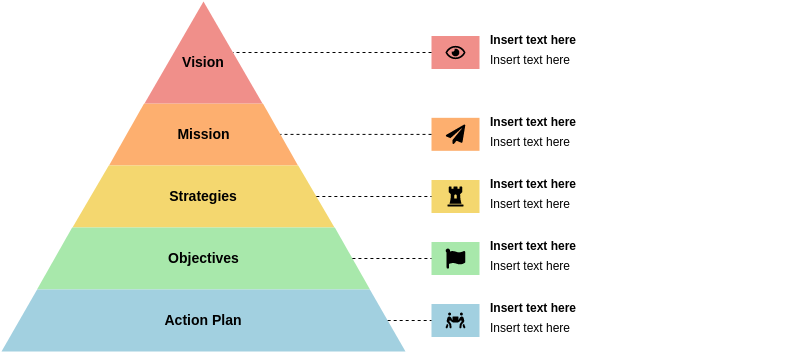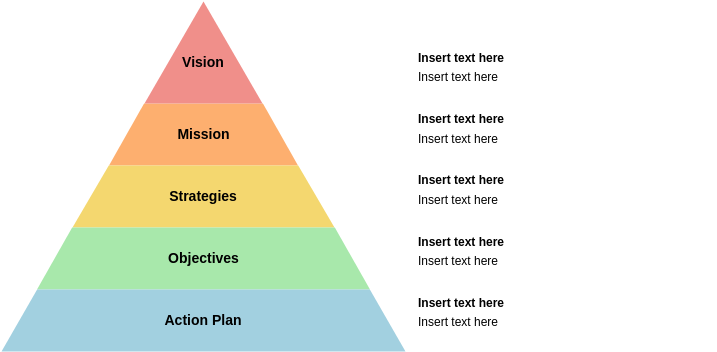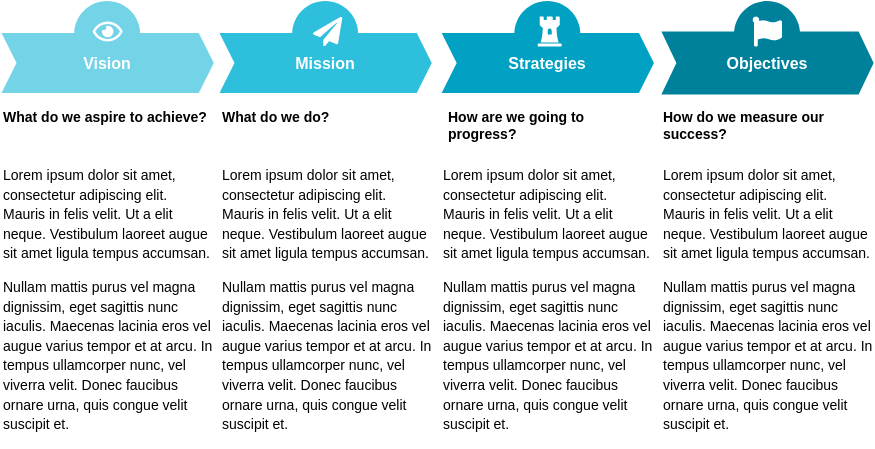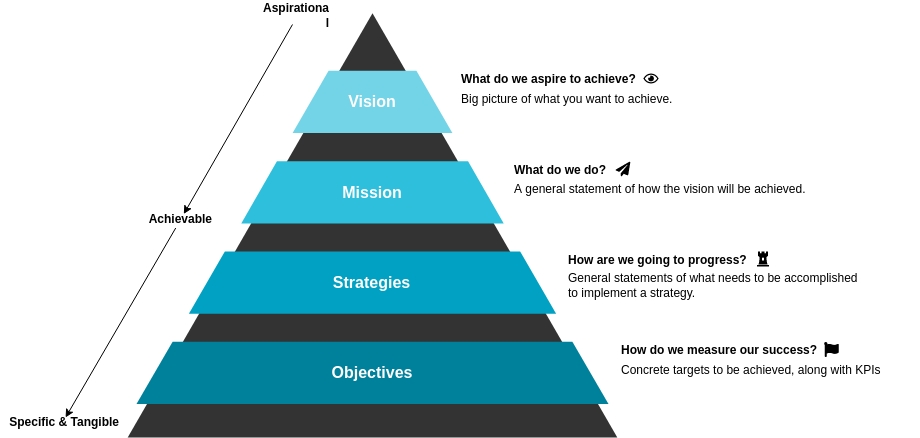Defining the foundational elements of an organization—its vision, mission, strategies, and objectives—is crucial for guiding its direction and ensuring long-term success. This article explores how to create these components, their relationships, and their significance.
Understanding the Components
Vision Statement
Definition: A vision statement outlines what the organization aspires to achieve in the future. It serves as a source of inspiration and a guide for decision-making.
How to Create:
- Identify Core Values: Consider the principles that are important to the organization.
- Envision the Future: Imagine where you want the organization to be in 5 to 10 years.
- Be Aspirational: Craft a statement that reflects high aspirations and motivates employees.
Example: “To be the leading provider of sustainable energy solutions worldwide.”
Mission Statement
Definition: A mission statement defines the organization’s purpose and primary objectives. It clarifies what the organization does, who it serves, and how it serves them.
How to Create:
- Define the Purpose: Clearly articulate why the organization exists.
- Identify Target Audience: Specify who the organization serves (customers, community, etc.).
- Outline Key Activities: Describe the main activities or services offered.
Example: “To provide innovative and sustainable energy solutions that empower communities and protect the environment.”
Strategies
Definition: Strategies are the high-level plans that outline how the organization will achieve its mission and move toward its vision.
How to Create:
- Assess the Environment: Conduct a SWOT analysis (Strengths, Weaknesses, Opportunities, Threats) to understand the competitive landscape.
- Set Priorities: Identify key areas to focus on based on the assessment.
- Develop Action Plans: Outline specific strategies for resource allocation, marketing, operations, etc.
Example: “Expand market presence through partnerships and enhance product offerings in renewable technologies.”
Objectives
Definition: Objectives are specific, measurable targets that the organization aims to achieve within a set timeframe. They break down the strategies into actionable steps.
How to Create:
- Make Them SMART: Ensure objectives are Specific, Measurable, Achievable, Relevant, and Time-bound.
- Align with Mission and Vision: Ensure that objectives support the mission and move the organization toward its vision.
- Set Milestones: Establish intermediate goals to track progress.
Example: “Increase renewable energy sales by 20% within the next fiscal year.”
The Relationship Between Vision, Mission, Strategies, and Objectives
- Vision: The foundation that sets the long-term direction of the organization.
- Mission: A clear articulation of the organization’s purpose that informs the strategies.
- Strategies: High-level plans derived from the mission that guide how the organization will achieve its goals.
- Objectives: Specific, actionable targets that stem from the strategies, making the vision and mission operational.
Why It Is Necessary
- Clarity and Focus: Clear vision and mission statements help align everyone in the organization towards common goals, reducing confusion and ensuring that efforts are unified.
- Guidance for Decision-Making: These components serve as a framework for making strategic decisions, helping leaders choose actions that align with the organization’s purpose and long-term goals.
- Motivation and Engagement: A compelling vision and mission can inspire employees, fostering a sense of purpose and belonging within the organization.
- Performance Measurement: Well-defined objectives provide measurable benchmarks that help assess progress and performance, enabling continuous improvement.
Purpose of Creating a Vision, Mission, Strategies, and Objectives
The primary purpose of defining these elements is to create a coherent roadmap for the organization. This roadmap guides daily operations, informs strategic decisions, and helps navigate challenges while keeping the team focused on long-term aspirations.
Examples:
Here are some examples of vision statements, mission statements, strategies, and objectives from various organizations across different industries:
Examples of Vision Statements
- Tesla: “To create the most compelling car company of the 21st century by driving the world’s transition to electric vehicles.”
- Google: “To provide access to the world’s information in one click.”
- Oxfam: “A just world without poverty.”
Examples of Mission Statements
- Netflix: “To entertain the world by providing the best content, with the best experience, anywhere, anytime.”
- Patagonia: “We’re in business to save our home planet.”
- American Red Cross: “To prevent and alleviate human suffering in the face of emergencies by mobilizing the power of volunteers and the generosity of donors.”
Examples of Strategies
- Coca-Cola:
- Diversify product offerings to include healthier options.
- Enhance digital marketing to reach younger consumers.
- Nike:
- Invest in technology and innovation for product development.
- Focus on sustainability initiatives to appeal to environmentally conscious consumers.
- Amazon:
- Expand logistics and delivery networks to ensure faster shipping.
- Increase the range of products available through partnerships and acquisitions.
Examples of Objectives
- Charity: Water:
- “Raise $1 million to fund clean water projects in Africa within the next year.”
- Starbucks:
- “Open 1,000 new stores globally in the next two years.”
- Microsoft:
- “Achieve carbon negativity by 2030.”
These examples illustrate how different organizations articulate their vision, mission, strategies, and objectives. Each component serves a specific purpose, guiding the organization towards its overarching goals and helping to align internal efforts with external aspirations.
Visualizing Vision, Mission, Strategies, and Objectives in an Infographic
Creating an infographic to represent the vision, mission, strategies, and objectives of an organization offers several advantages. Here’s why visual representation is beneficial, along with a sample outline for the infographic:
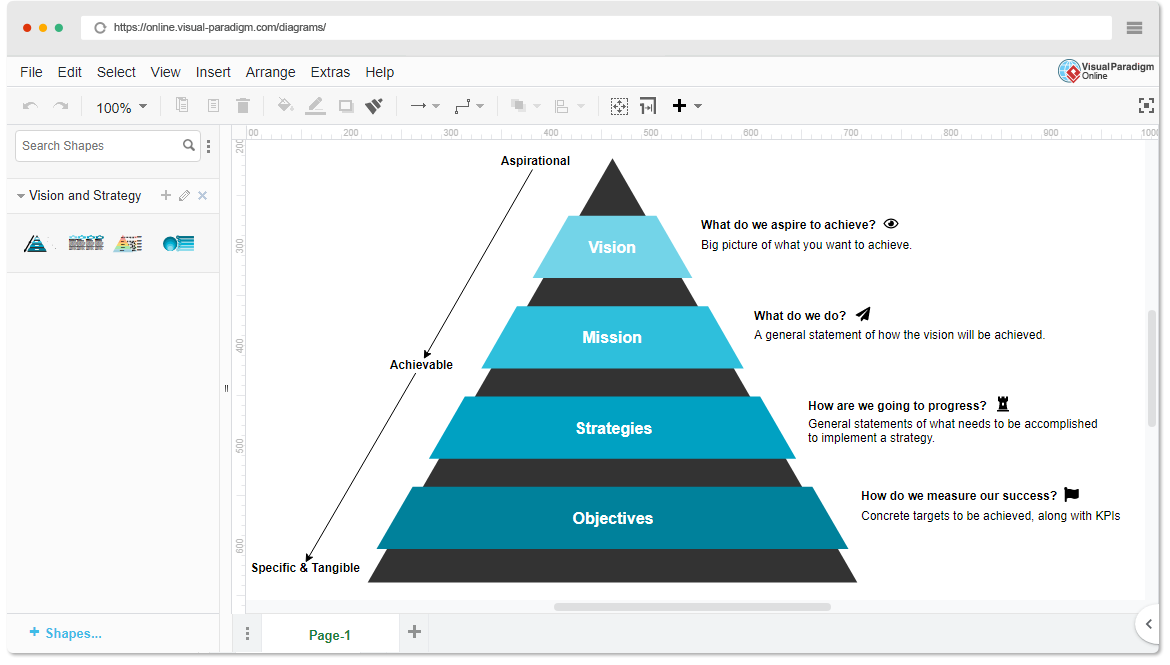
Edit Infographic with Visual Paradigm Online
Advantages of Using an Infographic
- Clarity: Visuals simplify complex information, making it easier to understand the relationships between components.
- Engagement: Infographics are more engaging than text-heavy documents, capturing the audience’s attention.
- Memorability: People are more likely to remember information presented visually, enhancing retention.
- Quick Reference: Infographics provide a concise overview, allowing stakeholders to quickly grasp essential concepts.
- Enhanced Communication: Visuals facilitate better communication among team members, promoting alignment and shared understanding.
Suggested Infographic Structure
Here’s an outline for an infographic representing the Vision, Mission, Strategies, and Objectives:
Title: Organizational Framework: Vision, Mission, Strategies, and Objectives
1. Vision (Top of the pyramid)
- Text: “What do we aspire to achieve?”
- Description: A big picture of what the organization hopes to become.
2. Mission (Middle section)
- Text: “What do we do?”
- Description: A general statement of purpose and core activities.
3. Strategies (Lower middle section)
- Text: “How are we going to progress?”
- Description: General statements of how the mission will be accomplished.
4. Objectives (Base of the pyramid)
- Text: “How do we measure our success?”
- Description: Specific, measurable targets that indicate progress.
Visualizing the vision, mission, strategies, and objectives in an infographic format enhances understanding and communication within an organization. It serves as a quick reference that reinforces alignment and motivation among team members, making it a valuable tool for strategic planning and execution.
Why Visual Paradigm Online is the Ultimate Choice for Diagramming
Visual Paradigm Online stands out as an exceptional tool for creating infographics and diagrams that effectively communicate an organization’s vision, mission, strategies, and objectives. Here are several reasons why it is the ultimate choice:
1. User-Friendly Interface
- Intuitive Design: The drag-and-drop functionality enables users to create diagrams easily, regardless of their design experience.
- Pre-built Templates: A wide variety of templates for infographics and diagrams help users get started quickly.
2. Comprehensive Diagramming Tools
- Versatile Options: Supports a broad range of diagram types, including mind maps, flowcharts, and organizational charts, making it suitable for various needs.
- Customizable Elements: Users can customize shapes, colors, and text to align with their branding and messaging.
3. Collaboration Features
- Real-Time Collaboration: Multiple team members can work on the same diagram simultaneously, enhancing teamwork and facilitating feedback.
- Commenting and Annotation: Users can leave comments directly on the diagram, streamlining communication and revisions.
4. Cloud-Based Accessibility
- Access Anywhere: Being cloud-based means users can create and edit diagrams from any device with internet access, providing flexibility for remote teams.
- Automatic Saving: Changes are saved automatically, reducing the risk of data loss.
5. Integration Capabilities
- Seamless Workflow: Integrates with various tools and platforms (like Google Drive, Microsoft Teams, etc.), making it easy to incorporate diagrams into existing workflows.
6. Export Options
- Versatile Formats: Diagrams can be exported in multiple formats (PNG, PDF, SVG, etc.), ensuring compatibility with various presentation and documentation needs.
7. Version Control
- Track Changes: Users can track changes made over time, allowing for easy reversion to previous versions if needed.
8. Learning Resources
- Tutorials and Support: Visual Paradigm provides extensive tutorials and customer support, helping users maximize the tool’s potential.
Conclusion
Creating a vision, mission, strategies, and objectives is essential for any organization seeking to thrive in today’s dynamic environment. By clearly articulating these components, organizations can ensure alignment, drive performance, and inspire all stakeholders to work towards a unified future. This foundational work lays the groundwork for sustainable growth and success.
Visual Paradigm Online is the ultimate choice for organizations looking to create effective infographics and diagrams. Its user-friendly interface, comprehensive features, and collaboration capabilities make it an invaluable tool for visually communicating complex information like vision, mission, strategies, and objectives. By utilizing Visual Paradigm Online, organizations can enhance clarity, engage stakeholders, and drive alignment towards their goals.
Strategic Tactical Planning Template
Vision and Mission Strategic Management Template
